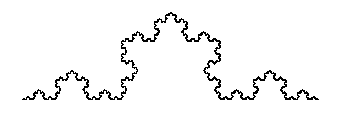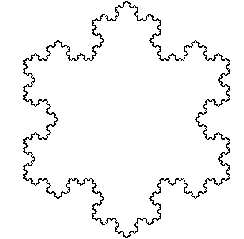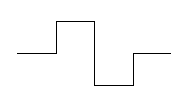| Stage 0 |  |
| Stage 1 |  |
| Stage 2 |  |
| Stage 3 |  |
Fractals are geometric objects that are self-similar and have detail on arbitrarily small scale. Although true fractals probably do not exist in the physical world, they are easy to create in the mathematical world. Moreover, many real-word objects are so complex that fractals may provide a better way to study them than traditional geometric figures. As an example, consider the view of a coastline from a space shuttle orbiting the earth. A coastline is certainly not a line, nor is it a circle or a parabola; it is much more jagged than can be described by standard geometry. Now imagine the space shuttle approaching the earth, with the coastline in view. Will the coast appear more like a line or a smooth curve as you get closer? Certainly not! As you get closer, you are simply able to see irregularities that could not be seen from the greater distance--and the coastline continues to appear irregular. Indeed, a small piece of the coastline may even have a shape similar to that of the larger view, down to the smallest bays and inlets, and even down to the rocks that line the coast.
Creating Fractals
Fractals can be created easily by a process known as "iterated subset
replacement." We begin with a simple geometric set, such as a line
segment. At "Stage 1," we replace the line segment with another shape,
perhaps consisting of several line segments in a certain pattern.
We then create Stage 2 by applying the Stage 1 replacement to every line
segment in Stage 1. We iterate this subset replacement scheme indefinitely,
and the limiting set is an instance of a fractal. As an example,
consider the following construction, in which the replacement process is
to replace a segment by the shape obtained by removing the middle third,
and drawing instead the other two sides of an equilateral triangle.
This is much easier to visualize than it is to describe in words:
| Stage 0 |  |
| Stage 1 |  |
| Stage 2 |  |
| Stage 3 |  |
Since the actual fractal is the limit of an infinite sequence of steps, we can draw only an approximation of the true fractal:

This fractal is known as the Koch curve. Notice that if you were to magnify any portion of the Koch curve, you would see miniature replicas of the Koch curve contained within itself. This idea of self-similarity is a hallmark of fractals.
Putting three of these Koch curves together, we obtain the Koch snowflake:

Some Other Fractals
Many other fractals can be created through iterated subset replacement.
As examples, see if you can draw the various stages indicated in the following
exercises:
| Replace this set... | ...by this set. | Try to draw... | Click for solution. |
 |
 |
Stage 3 | Solution |
 |
 |
Stage 2 | Solution |
 |
 |
Stage 6 | Solution
(The associated fractal is known as the Sierpinksi gasket.) |
Other Types of Fractals
The technique of iterated subset replacement is only one way of generating fractals. In later vignettes, you will see some fractals that are created by very different methods.
Further Exploration